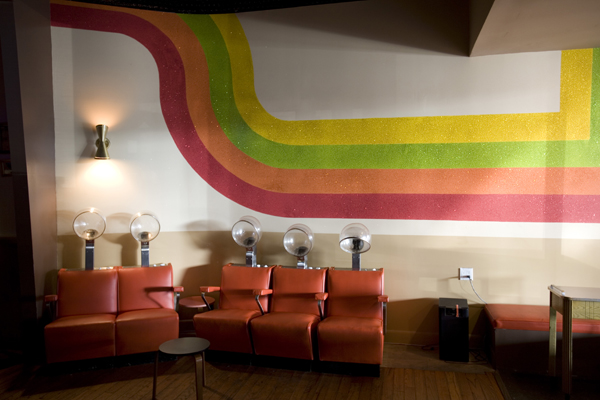Monday, December 5, 2011
Sunday, August 28, 2011
Tuesday, July 26, 2011
The Beauty Bar
Chain of bars around the US based on vintage beauty salons. Drink specials include manicures. I worried that men might not come to these bars, but pictures seem to show lots of them there!
http://thebeautybar.com/index.php
http://thebeautybar.com/index.php
Sunday, July 10, 2011
Joel Anderson Photography
I went to the Art Fair on the Square today and had two favorite photographers. One is Joel Anderson (www.joelandersonphoto.com). I love his ability to find rural, "undiscovered" spots. He also has an ability to catch animals into poses. Use of light is great.
This is the photo that made me stop inside his booth:
This is the photo that made me stop inside his booth:
Thursday, April 21, 2011
Disney Short "The Little House"
I grew up watching this videotape, but at age 6 I never really noticed the social commentary within this Disney cartoon. It's anti-urbanism and idealizes the countryside. Maybe a little biased, but interesting insight. I think the cartoon is from the 1950s.
Wednesday, April 20, 2011
Fernando Vicente
Spanish artist Fernando Vicente creates drawings and paintings based on the shapes he sees in maps, sometimes rotating the map in unexpected ways.
http://fernandovicenteatlas.blogspot.com/
http://fernandovicenteatlas.blogspot.com/
Tuesday, April 12, 2011
New York's High Line
http://ngm.nationalgeographic.com/2011/04/ny-high-line/goldberger-text
Parks in large cities are usually thought of as refuges, as islands of green amid seas of concrete and steel. When you approach the High Line in the Chelsea neighborhood on the lower west side of Manhattan, what you see first is the kind of thing urban parks were created to get away from—a harsh, heavy, black steel structure supporting an elevated rail line that once brought freight cars right into factories and warehouses and that looks, at least from a distance, more like an abandoned relic than an urban oasis.
Until recently the High Line was, in fact, an urban relic, and a crumbling one at that. Many of its neighbors, as well as New York's mayor for much of the 1990s, Rudolph Giuliani, couldn't wait to tear it down. His administration, aware that Chelsea was gentrifying into a neighborhood of galleries, restaurants, and loft living, felt the surviving portion of the High Line, which winds its way roughly a mile and a half from Gansevoort Street to 34th Street (a section farther south was torn down years ago), was an ugly deadweight. They were certain this remnant of a different kind of city had to be removed for the neighborhood to realize its full potential.
Never have public officials been so wrong. Almost a decade after the Giuliani administration tried to tear the High Line down, it has been turned into one of the most innovative and inviting public spaces in New York City and perhaps the entire country. The black steel columns that once supported abandoned train tracks now hold up an elevated park—part promenade, part town square, part botanical garden. The southern third, which begins at Gansevoort Street and extends to West 20th Street, crossing Tenth Avenue along the way, opened in the summer of 2009. This spring a second section will open, extending the park ten more blocks, roughly a half mile, to 30th Street. Eventually, supporters hope, the park will cover the rest of the High Line.
Miracle Above Manhattan
New Yorkers can float over busy streets in an innovative park.
By Paul Goldberger
Photograph by Diane Cook and Len Jenshel
Parks in large cities are usually thought of as refuges, as islands of green amid seas of concrete and steel. When you approach the High Line in the Chelsea neighborhood on the lower west side of Manhattan, what you see first is the kind of thing urban parks were created to get away from—a harsh, heavy, black steel structure supporting an elevated rail line that once brought freight cars right into factories and warehouses and that looks, at least from a distance, more like an abandoned relic than an urban oasis.
Until recently the High Line was, in fact, an urban relic, and a crumbling one at that. Many of its neighbors, as well as New York's mayor for much of the 1990s, Rudolph Giuliani, couldn't wait to tear it down. His administration, aware that Chelsea was gentrifying into a neighborhood of galleries, restaurants, and loft living, felt the surviving portion of the High Line, which winds its way roughly a mile and a half from Gansevoort Street to 34th Street (a section farther south was torn down years ago), was an ugly deadweight. They were certain this remnant of a different kind of city had to be removed for the neighborhood to realize its full potential.
Never have public officials been so wrong. Almost a decade after the Giuliani administration tried to tear the High Line down, it has been turned into one of the most innovative and inviting public spaces in New York City and perhaps the entire country. The black steel columns that once supported abandoned train tracks now hold up an elevated park—part promenade, part town square, part botanical garden. The southern third, which begins at Gansevoort Street and extends to West 20th Street, crossing Tenth Avenue along the way, opened in the summer of 2009. This spring a second section will open, extending the park ten more blocks, roughly a half mile, to 30th Street. Eventually, supporters hope, the park will cover the rest of the High Line.
Sunday, April 10, 2011
Subscribe to:
Posts (Atom)


















































